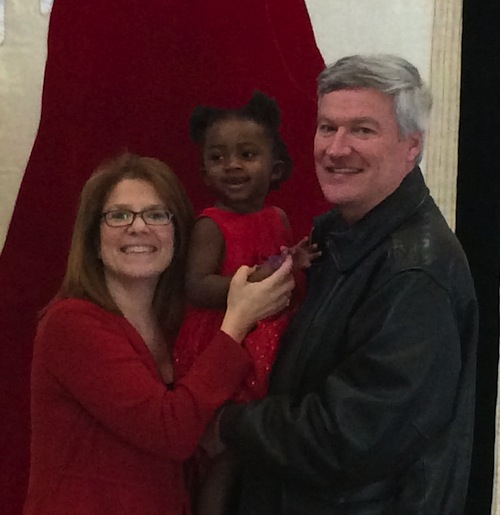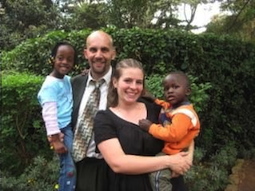The Redeeming Act of Adoption
Three couples share their pursuit of different adoptions — domestic newborn, foster-to-adopt and international — and the graces they received.
Driven by love and fueled by faith, no challenge — from the cost to the paperwork and sometimes foreign travel — deters some couples from their desire to adopt a child. Those who successfully do so say the reward of their children far exceeds the struggles they went through to get them. Here, three couples share their pursuit of different adoptions — domestic newborn, foster-to-adopt and international — and the graces they received.
Leap of Faith: The Sotos
Married nearly a decade, classical musician Max Soto, 37, and his Pilates instructor wife, Gina, 36, always hoped to have children.
“We were one of those couples who thought we’d get pregnant whenever we wanted to,” Gina said in the dining room of their Denver brick bungalow. “We didn’t.”
A brief go at Catholic-approved infertility treatments didn’t resonate with health-conscious Gina, who felt she was trying to force her body to get pregnant.

“We got to this point where we thought, ‘Do we want to be pregnant or do we want to be parents? Oh — we want to be parents!’” she said. “At that point, we felt maybe God was calling us to start our family in a different way.”
“We thought, ‘We’ll just go for adoption,’” Max said. “Not that it’s easier, but we’d have a plan.”
Excited by their decision to try to adopt a U.S. infant, their anticipation turned to astonishment as they faced the formidable adoption costs (average $20,000-$35,000) and process (typically two years). They picked an adoption agency (required in Colorado and some other states), attended mandatory state training, gathered documents, including tax and medical records, were fingerprinted, underwent background checks and penned autobiographies.
Recently paired with a caseworker, they have begun the home-study process, which is required for both domestic and international adoptions and takes from three to six months to complete.
“[When that’s done] we have to submit our first $10,000 payment,” Gina said, explaining it’s about a third of the total fee they will pay.
To raise the full $30,000, which amounts to about half their annual income, Max, who plays the oboe, plans to perform a benefit concert called Bach for Babies, perhaps at their parish, and the couple has started a blog (babysotoadoption.blogspot.com) to keep supporters informed.
They’ll also create a profile the adoption agency Hope’s Promise in Castle Rock, Colo., will use to market the Sotos to birth parents, which is necessary, as the number of families waiting for newborns exceeds the number eligible for adoption.
“On average, for every infant placed for adoption, there are 45 to 50 adoptive couples waiting,” said agency executive director Beth Woods, explaining that birth rates are at an all-time low, and more resources are available to help women with unintended pregnancies parent their children.
Gina and Max admire the birth mothers who choose to parent their children and appreciate the selfless courage of those who relinquish their infants to adoption. Describing the adoption process as necessary and beneficial, but “daunting,” they intend to persevere because they yearn to be parents.
“God will make it work,” Gina declared. “We’re taking a leap of faith.”
True Peace: The Wultiches
While exploring adoption, Broomfield, Colo., couple Tom Wultich, 53, an information technology manager, and Ann, 47, a university MBA instructor, discovered their local Catholic Charities foster-to-adopt program.
“We went to a session … and felt this was our calling,” Ann said of the program, in which families foster-parent children while waiting to adopt them.
“This was the right fit,” added Tom, “and there was a big need.”
In the United States, nearly 102,000 children living in foster care are eligible for adoption, according to the Department of Health and Human Services. Of these children, nearly a third will spend more than three years in foster care before being adopted. Some will never have a permanent home.
“That’s where the need is,” said Melissa Maile, family services director for Catholic Charities Denver. “There just aren’t enough adoptive families available for foster care.”

The average cost to adopt a child through foster care is $0-$3,000, but state subsidies are often available to help with the child’s needs.
Children adopted through foster care range in age from infants to 17-year-olds, with 8 years as the average. While the wait for placement and adoption through foster care is unpredictable, it can be quick.
The Wultiches’ application, training and certification process took less than six months, and they received their child soon afterward.
“In April, we got certified, and the first week of May she was available,” Ann said about getting their then-5-month-old daughter, Saraya, in 2013.
“We got the call (from Catholic Charities) saying they had a little girl (in need of a home); they didn’t have a lot of information about her,” Tom recalled. With a laugh, he added that when he and Ann said they could take her, they were told, “We’ll bring her tomorrow!”
The Wultiches’ adoption of now 2-year-old Saraya was finalized last July.
“She’s our blessing,” Ann said. “When we received her, she was a bit behind — she had some physical and emotional issues; now, she’s healthy. You would never have known her tough start.”
The risks of adopting through the foster-to-adopt system include accepting a child who has experienced trauma from family crisis, abuse or neglect and the uncertainty of keeping the child.
“The focus and the goal is (the welfare of) the child,” Tom said. “Ideally, the child goes back to the family (of origin, if problems are corrected). You support that, and you root for that. The uncertainty is tough. But you meet these kids, and you take the risk.”
Maile said she admires the valor of the families who open their hearts and homes to children they may have to “love and let go.”
“How challenging that is,” she said. “But the time those children spend with that family, whatever the outcome, is invaluable.”
Married just five years and with room to spare in their lives and comfortable home, the Wultiches hope to continue to add to their family, either biologically or through the foster-to-adopt program.
“Our experience was really, really positive,” Tom said. “This is the hardest thing I’ve ever done — and the most rewarding.”
Not only did the couple get a delightful daughter they dote on, but they also gained a network of support — from a “wonderful caseworker” to a “fantastic” team of doctors — and a community of like-minded foster and adoption families who are now friends.
In a homily, Tom once heard then-Denver Archbishop Charles Chaput describe peace as “the realization you’re doing what you’re supposed to be doing — then your soul’s at peace.”
“When I’m with (Saraya),” Tom said choking back tears, “I have peace.”
Redemption: The Smiths

While reading the Bible as a college freshman one day, a verse describing the responsibilities of the Christian caught Jeromy Smith’s attention, and he vowed that, when he married, he would adopt children
“James 1:27 gives a definition of pure and undefiled religion,” 39-year-old Smith, an IT manager, said by phone from his Columbia, Md., office. “It is looking after orphans and widows and keeping yourself from being polluted by the world.”
In the Scriptures, orphans and widows represent the most vulnerable and oppressed in society. Today, according to UNICEF, there are some 153 million orphans worldwide, living in orphanages or on the streets.
When Smith met his now-38-year-old wife of 10 years, Kimberly, he shared his hopes to adopt children — unaware of her own passion for adoption.
“That’s when I really started considering him as a partner,” Kimberly said, adding that since childhood she had dreamed of someday adopting kids or starting an orphanage in a foreign country.
Nondenominational Christians, the two have four children, whom Kimberly homeschools. Their eldest two—daughter Sundi, 12, and son Damon, 8—were adopted from Kenya. Two biological sons, Jasiri, 6, and Amani, 3, were unexpected blessings.
“I guess God had other plans,” Jeromy said with a laugh.
Jeromy met Sundi when he visited an orphanage during a trip to Kenya in 2005. She was 2. He says she essentially adopted him.
“She grabbed my hand and refused to let it go,” he recalled. “It was super sweet.”
The next year, the Smiths started the international adoption process (average two years), which can be complex because of working with two countries and can be more expensive (typically $25,000-$50,000) due to travel costs. (As with other adoptions, a federal tax credit can help offset expenses.)
“In Kenya, there is a foster-care period where you live with the child for three months; after that, you start a lengthy court proceeding,” Kimberly said, describing the process.
Kimberly ultimately lived in Kenya for a year, and the couple ended up adopting both Sundi, who was then 5, and Damon, 1, at the same time in 2008.
“There were challenges,” Jeromy admitted. “We worked hard to save money, and God provided. The biggest challenge for me is knowing that your child came from a place of pain — whatever it is that makes you an orphan creates a lot of pain. Not being able to reach in and fix that immediately has been the greatest challenge.”
Because Jeromy had to return to their U.S. home to work, Kimberly faced the burden of parenting a child with special needs alone for a year in a foreign country — Sundi is hearing impaired and had delayed language skills.
But the Smiths say the graces of adoption outnumber its trials.
“Our kids are just amazing,” Jeromy said. “I feel so blessed to be their dad and can’t imagine life without them. As an adoptive father, I better understand God’s love for me as his adopted child.”
“The gift you get is so much more than what you give,” added Kimberly. “You get to watch that person blossom. You see such a difference in their personality and an explosion of love and hope.”
Not only did the Smiths grow a loving family, but they also gained a second home and family through love for another nation and its people.
“With an international adoption,” Kimberly said, “there’s a whole new culture that enters your life.”
Their experience inspired them to found the nonprofit We Are Kenya (WeAreKenya.org), which partners with indigenous groups in Kenya to provide food, clothing, shelter and education to impoverished children.
In blog posts for their nonprofit, Kimberly notes that they’ve witnessed redemption.
“I love the word ‘redemption,’” she wrote. “We often use it as we speak of salvation. While that is true, I rather like to use it when thinking of someone whose life was ‘nothing’ … men or women and children whose lives are redeemed from the poverty of hope to a life of purpose.”
Adoption expert Woods agrees.
“The best thing about adoption is the redeeming quality of it,” she said. “For couples who have struggled with infertility or multiple miscarriages or infant loss, it’s the opportunity to be blessed with a child and to become parents.
“For women with unintended pregnancies who don’t feel equipped at that point … to raise a child, it’s an opportunity to take care of the child … to put the child first, but it also allows them an opportunity for redemption in their lives.”
Roxanne King writes from Denver.
- Keywords:
- adoption
- catholic families
- roxanne king

















